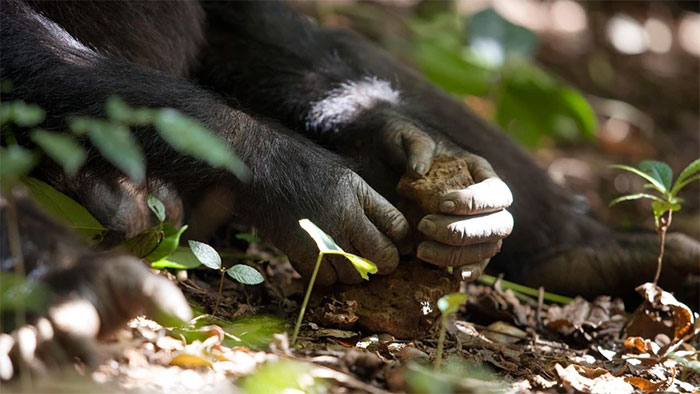East African chimpanzees have literally entered the Stone Age.
In a surprising discovery recently revealed to the scientific community, East African chimpanzees have demonstrated incredible intelligence and skills. According to new research, these cute chimpanzees have entered the Stone Age.
The Remarkable Evolution of Chimpanzees in East Africa: From Wild Primates to Stone Age Civilization
The East African chimpanzee (Pan troglodytes) is one of the most intelligent primates in the world. They live in the forests of eastern Africa and have an amazing evolutionary history.
In addition to humans, chimpanzees in East Africa have been observed to use tools. Initial research has shown that they can use tree branches as spears to catch small mammals for food. This is the first known example of chimpanzees using tools, demonstrating their spontaneous problem-solving abilities.

Recent studies have shown that chimpanzees can even master the skills of digging and building houses, which not only demonstrates their intelligence but also reveals their complex social structure.
Further research has shown that these chimpanzees have learned to use leaves as drinking tools and rocks on the ground as bedding material for sleeping. This shows that East African chimpanzees are very proficient at utilizing a variety of tool uses , and that this creativity and adaptability allows them to survive in different environments.
The most remarkable evolutionary achievement of East African chimpanzees is their Stone Age civilization . Through long-term research, scientists have observed a behavior in natural chimpanzee communities that is closely related to local stone materials. They bang stones against tree trunks and branches to create sounds with various meanings.

The remarkable evolutionary history of chimpanzees in East Africa provides a rich picture of their relationship with tools, the development of stone technology, and the beginnings of civilization.
What is even more surprising is that when male chimpanzees build their nests, they choose specific shapes and arrangements of rocks to enhance their structural stability. Their skill and creativity in using rocks allowed chimpanzees to build more complex nests that could withstand wind, rain, and humidity, thus providing the basis for the development of their civilization.
In addition to stone use, East African chimpanzees also demonstrate other stone-working skills . Scientists have observed chimpanzees selecting hard rocks, hammering them into specific shapes, and then using them to catch insects or make weapon-like attacks. The development of this stone tool technology suggests that East African chimpanzee societies have a certain cultural inheritance, and the technology has been accumulated and passed down.

Despite the great distance between them and humans, the evolutionary history of East African chimpanzees still makes us curious and amazed by the wonder and diversity of the natural world.
The evolutionary history of chimpanzees in East Africa provides us with invaluable evidence. Through observation and research, we learn about their close relationship with tools and the development of stone tool technology . This reflects their ability to solve problems and adapt to their environment, and even shows a certain cultural inheritance and creativity. This is an amazing achievement for a non-human primate with similar evolutionary points to humans.
We also need to make it clear that compared to human civilization, the civilizational development of East African chimpanzees is still relatively limited. However, this does not diminish the value of the intelligence and creativity of East African chimpanzees.

The evolutionary journeys they represent remain important evidence of animal biodiversity and intelligence, and a reminder of our common ancestral relationship with them.
Reveals intelligence and complex social structures
Researchers have discovered that chimpanzees can learn skills like digging and building houses , a finding that sheds new light on their intelligence. In one experiment, researchers provided chimpanzees with simple tools like sticks and stones and taught them how to use them to dig and build simple burrows. Surprisingly, the chimpanzees quickly mastered these techniques and successfully dug wells and built simple houses.
These experiments show that chimpanzees not only have high IQs, but also have the ability to use tools and have certain construction skills. Chimpanzees can not only learn to use tools, but can also improve and innovate these techniques by observing and imitating their peers. This shows that chimpanzees have quite advanced cognitive abilities and social intelligence.

The Stone Age marked an important milestone in human civilization and chimpanzees, our closest relatives, have also evolved to a similar stage. (Illustration photo).
The social structure of chimpanzees was also revealed through these experiments. The study found that in the process of learning to dig and build houses, chimpanzees demonstrated a clear division of labor and cooperation. Some chimpanzees dug, some moved materials, and some built. This division of labor reflects the hierarchical structure and organizational pattern of chimpanzee society.
Cooperation and cooperation among chimpanzees are not simple individual behaviors but are based on complex social relationships and structures. Chimpanzee societies have a clear concept of group hierarchy and territory, and they maintain the stability of their social groups by establishing stable social relationships. The cooperative behavior among chimpanzees in the experiment was based on this social structure and relationship.

Chimpanzees can learn skills such as digging and building houses. (Illustration photo).
Studies of chimpanzees' mastery of digging and building techniques reveal their intelligence and complex social structures. Chimpanzees not only have high IQs, but they are also capable of using tools and performing certain construction skills. Research on chimpanzees not only helps us better understand these close relatives, but also contributes to our understanding of human intelligence and social structure.
- Close-up of chimpanzees
- Chimpanzees know how to use stone tools 4,300 years ago
- The mysterious ancient stone circles in the Middle East
- Hurricane No. 2, level 10, entered the South China Sea on the days of Tet
- HIV 'relatives' cause pandemic in African monkeys
- The first time chimpanzees catch crabs to eat in the wild
- Stone monkeys make tools as mature as humans
- Learn about African carnivorous pythons
- The chimpanzees join forces to chase apricot newspapers to occupy the antelope
- The United States banned chimpanzees for experiments
- The worst animals on the planet
- Africa faces the risk of breaking in half: Cracks long thousands of meters are evidence
 Animal 'suffering' after hibernation
Animal 'suffering' after hibernation Why do goats climb well?
Why do goats climb well? Scientists were surprised to see chimpanzees eating turtles
Scientists were surprised to see chimpanzees eating turtles Giant catfish died deadly due to drought in Thailand
Giant catfish died deadly due to drought in Thailand 7 million-year-old human remains bring evolutionary breakthrough, can rewrite history
7 million-year-old human remains bring evolutionary breakthrough, can rewrite history  Unprecedented behavior in chimpanzees surprised scientists
Unprecedented behavior in chimpanzees surprised scientists  The story of the 'human chimpanzee': Walking on two legs, liking women and the tragedy of the end of life
The story of the 'human chimpanzee': Walking on two legs, liking women and the tragedy of the end of life  Quarantined animals with infectious diseases
Quarantined animals with infectious diseases  Why do chimpanzees often ... throw feces on visitors?
Why do chimpanzees often ... throw feces on visitors?  The first time chimpanzees catch crabs to eat in the wild
The first time chimpanzees catch crabs to eat in the wild 